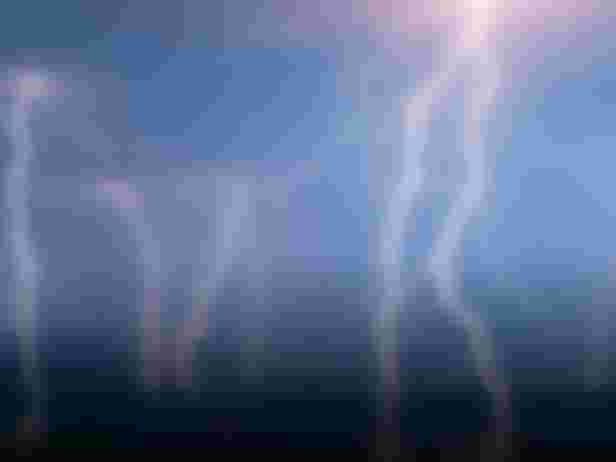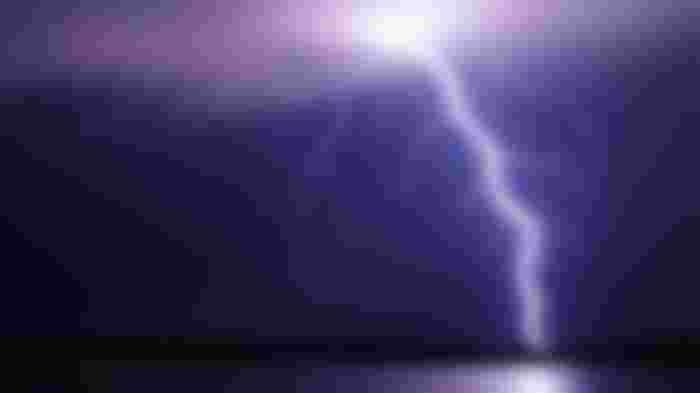
Lightning is a natural phenomenon. The heat from the sun warms the air near the earth's surface. We know that when heat is applied, the molecules in any object move a little farther away. When heat is applied to it, the object expands. In the case of air, the air becomes lighter as the molecules move away. This is because the amount of air molecules in a single density decreases. Here, if we take the meter as a unit, then the amount of air molecules in the volume of 1 cubic meter decreases. You can think of any other unit if you want, no problem. In any case, the light warm air continues to rise. And the cool air from the top continues to come down. As a result, reverse air collides and electrons are exchanged between them.
The cool air above contains small droplets of water and small particles of ice. These droplets and particles are positively charged by releasing electrons. And the electrons go into the soft snow rock, which is called the grapple. This is how lightning clouds are formed. At the top of this cloud accumulates positive charge, at the center and at the bottom there are rocks of negative charge. The result is a lot of static electricity. This wants electricity to flow.
Several incidents took place at this time. Negative charges on the surface of the earth and negative charges in the lower part of the cloud strongly repel each other. Again there is a difference in the amount of charge deposited in other clouds side by side and in different parts of the same cloud. All in all, a huge flow of electricity started. Electrons flow at a speed of about 260,000 miles per hour. Lightning is the current of this intense electricity. We see it as a zigzag ray of light.

This strong current of electricity creates a lot of heat. The surface temperature of the sun is 30,000 degrees Celsius. The heat generated by lightning is often higher than this. As a result, the air compresses and expands very fast, creating a sonic shock wave. This is the sound of lightning.The whole thing is very simple here. Because, this is not our main topic. The main issue is where is the most lightning?
We did not have such information about the spread of lightning and where and how much lightning occurs. Scientists then tried to understand where the sound of lightning was happening, depending on where it was happening, where the lightning was happening more. Now we have that information in our hands for the benefit of artificial satellites. As can be seen, lightning is more prevalent in different places at different times of the year. It depends on the place, time and climate. There are about 44 lightning strikes per second on Earth. That means lightning strikes about 1.4 billion times a year! 80% of it is either in the tropics or in the tropics.
Here we need to understand a little bit of geography. An imaginary line is thought to be at an equal distance from the two poles of the earth. Its name is equator. The northern side of this line is called the Northern Hemisphere, the southern side is called the Southern Hemisphere. Simply put, the region on either side of the equator is called the tropics. The tropical region of the Northern Hemisphere is called the Tropic of Cancer and the tropical region of the Southern Hemisphere is called the Capricorn. About 60% of lightning strikes occur in this tropical region. The North and South Poles and the oceans have the least amount of lightning.
According to 2004-05, the highest number of lightning strikes was in Lake Maracaibo, Venezuela. This is where most lightning strikes per square kilometer, several times per minute. And about 232 per square kilometer per year. Although few in number, the fastest thunderstorms occur in the Congo, a mountainous area around the village of Kifuka. In this region, 156 lightning strikes per square kilometer per year. 🤯

The Kahuji-Biyaga National Park in Congo is the second highest in terms of lightning. Some other areas in the Congo are also on the list of the 10 most lightning-prone areas. In third place is Teresina of Brazil. Indonesia, Colombia and Malaysia are also prone to lightning.
According to a 2016 study by NASA and the University of Maryland, Sunamganj in Bangladesh has the highest number of lightning strikes in the world from March to May. The number, however, is less, about 25 per square kilometer. According to the Finnish research institute Vaisala, about 4 million lightning strikes occurred in Bangladesh every year between 2015-16. In 2019, the number has decreased to 1 million. In 2020, it has gone up to 2.5 millions again.
Although lightning does not seem terrifying from a distance, it is not very pleasant for the region where it occurs. According to the Disaster Management Department, about 150 people are killed by lightning every year. The number '150' is small in number, but the amount of suffering for those whose family members die is unimaginable. It is not possible to tie it to any number. About 80 percent of these people are farmers. In other words, the death of such a person means the disintegration of a family.
References: NASA, CBS, Treehugger, Google



Lightning is also natural part. But it harms many lives when lands on earth. I have seen many live examples about its burn. Yeah! Its energy capacity is very high and can burn everything. Its the reaction of many gases and cloud thundering as the bookish knowledge reveals. But its exact case is still unknown.